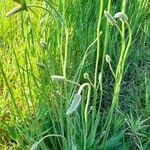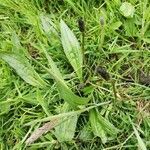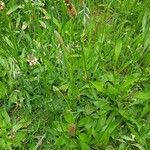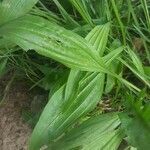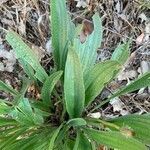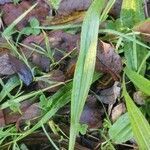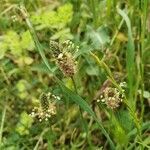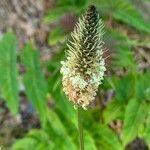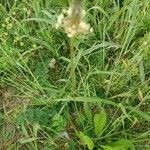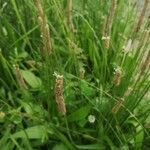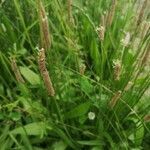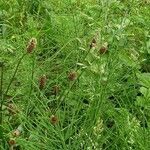Perennial herb with persistent taproot. Lvs all radical, rosulate, hairy; petiole 1-7-(20) cm long, channelled, with silky white tuft of hairs and often purplish at base. Lamina 2-20 × 0.5-4.8 cm, linear-lanceolate to elliptic-lanceolate or elliptic, 3-7-veined, glabrate or hairy, especially on the veins beneath, sometimes villous when young and sometimes remaining ± villous, entire or slightly toothed; base attenuate to the ill-defined petiole; apex acute to short-acuminate. Scape 12-70 cm long, sparsely to densely clothed in antrorse hairs, strongly ribbed. Spike very congested, to c. 6 cm long, ± oblong, occasionally infl. capitate, sometimes with short subsidiary spikes near base. Bracts 3-6 mm long, acuminate; keel green, the upper part of bract otherwise brown. Sepals (2.3)-2.7-3.5 mm long, unequal with anterior pair fused; midrib green, often hairy; upper part otherwise brown; margin usually membranous. Corolla tube = calyx; lobes c. 2 mm long, ovate, patent or reflexed, concave. Stamens glabrous, exserted. Styles exserted, occasionally to 15 mm long, densely hairy. Capsule usually 2.5-3.5 mm long, ellipsoid, (1)-2-seeded. Seeds 2-3 mm long, ellipsoid, medium to dark brown; inner surface concave, with involute margin.
An extremely variable glabrous, pubescent or more rarely densely pilose perennial herb from a ± erect, thick, short rhizome; stem silky hairy.. Leaves borne in a rosette, spirally arranged; blade linear-lanceolate, ovate-lanceolate or spathulate, (2-)10-15(-45) cm. long, 0.7-3(-8) cm. wide, acute or acuminate at the apex, usually entire or somewhat toothed, 3-5(-7)-veined, mostly gradually narrowed into a petiole usually equalling the blade in length but occasionally much shorter or much longer.. Inflorescence spicate, the spikes cylindric to globose, (0.3-)0.5-3.5(-10) cm. long; peduncles 5-120 cm. long, mostly furrowed and silky; bracts ovate-acuminate, 4-7 mm. long, dark blackish-green, with scarious points.. Sepals rounded-ovate, 3-3.5 mm. long, glabrous or hairy on the margins or keels, the lower pair joined to form an obovate, ± bilobed 2-keeled organ.. Corolla brownish-white, 3 mm. long; lobes narrowly ovate or ovate, 2-2.5 mm. long.. Anthers mostly white.. Capsule ellipsoid, 3-6 mm. long, 1-2-seeded.. Seeds yellow-brown to dark brown, shining, oblong-ellipsoid, 2.5-3 mm. long, 1.5 mm. wide, dorsal side convex, ventral side concave; hilum dark.. Fig. 1/7-9, p. 3.
Fibrous-rooted perennial with a stout erect caudex, often flowering the first year, ± tan-woolly at the crown; lvs usually ascending, villous to glabrous, 3–several-nerved, narrowly elliptic or lance-elliptic, long-acute, 1–4 dm × 1–4 cm; scapes strongly 5-sulcate, strigose above, 1.5–6 dm; spikes very dense, ovoid-conic at first, at maturity cylindric, 1.5–8 cm × nearly or fully 1 cm; bracts thin, ovate, broadly scarious-margined, often caudate-tipped; sep often villous-ciliate toward the tip of the strong midnerve, the 2 outer connate with separate midveins, merely notched at the tip, or entire; cor-lobes 2–2.5 mm, spreading or reflexed; fr 3–4 mm, circumscissile near the base, the (1)2 seeds shining, blackish, 2 mm, deeply concave on the adaxial face; some fls or plants sometimes pistillate; 2n=12. Native of Eurasia, now a cosmopolitan weed, particularly in moister parts of the temperate zone, common in lawns and along roadsides.
Persistent herb with a short, inconspicuous rhizome, the roots tough and appearing fibrous. Leaves numerous, lanceolate, to 30 cm long, gradually narrowed into the petiole, strongly ribbed with usually 5 parallel veins, glabrous when mature except for the ribs beneath and a dense tuft of whitish hairs at the base of the petiole. Scape slender, longer than leaves, glabrous or pubescent. Flowers in a dense, capitate, globose, or cylindrical spike, the lowermost bracts enlarged to form an involucre, flowering proceeding from the bottom upwards giving the spike a very different appearance at different stages; bracts in the inflorescence cucullate, with a light green midrib and hyaline, often erose margins, broadly ovate with an elongate stipe, 4-7 mm long; sepals 3-3.5 mm long, erose-margined, emarginate apically; corolla lobes 2 mm long; anthers
Perennial herb, glabrous to pilose. Leaves with petiole (1–) 3–8 (–15) cm long, hairy or pilose, with a silky tuft of hairs at base; lamina narrowly lanceolate to elliptic-lanceolate, (3–) 8–15 (–30) cm long, (0.5–) 1–2.5 (–3) cm wide, long-attenuate at base, entire or weakly, distantly toothed, acute, 5-veined. Scape 8–60 cm long, pilose, strongly ribbed. Inflorescence ovoid to cylindrical, 1–6 cm long. Sepals unequal, elliptic, 2.5–4 mm long; anterior pair almost completely connate. Corolla tube c. 3 mm long; lobes ovate, 1.5 mm long, almost apiculate, brownish. Anthers lanceolate, 1.5 mm long. Ovary 2-locular; ovule 1 per locule; style 4–5 mm long. Capsule ellipsoidal, 3–4 mm long, 2-seeded. Seeds 2.5–3 mm long, yellow to pale brown.
Perennial herb, 0.02-0.80 m high. Leaves in a basal rosette, linear to narrowly lanceolate or oblanceolate, up to 370 x 35 mm, glabrous; petioles up to 125 mm long. Inflorescences: scapes many per rosette, up to 700 mm long; bracts glabrescent, apex subobtuse. Calyx lobes elliptic, ± 2.5 x 1.3 mm, winged, obtuse. Corolla lobes deltoid, ± 2.0 x 1.2 mm, acute. Flowering time all year. Fruit an ellipsoid capsule, ± 3.5 x 1.5 mm. Seeds boat-shaped, up to 4 per capsule, dark brown, 2.8 x 1.6 mm, hilum scar in a ventral depression almost along as seed.
A herb which keeps growing from year to year. It has a well developed taproot. The leaves have stalks. The leaves are 2.5-30 cm long. They are sword shaped and taper to the tip. They can have teeth along the edge. The leaves have 3-7 easy to see veins running along them. The leaves have soft slender hairs. The flower stalks do not have leaves. The flower stalk is usually longer than the leaves. The flower stalk is usually deeply furrowed. The flowers are yellowish.
Lamina (2) 8–25 (45) × 0.5–3.5 (8) cm., linear-lanceolate, ovate-lanceolate or spathulate, gradually narrowed into the petiole, entire or revolutely and shallowly dentate (3) 5 (7) veined, glabrous, appressed-pubescent or villous, apex acute or acuminate; petiole 2–21 cm. or longer, caulicate, flexible, glabrous or rarely pubescent.
Perennial herb; scape up to 0.8 m high. Leaves in a basal rosette, petiolate; blade linear to narrowly ovate or obovate, 65-370 x 6-35 mm, glabrous or pubescent. Flowers: spike < 1/2 as long as peduncle, 15-70 mm long; corolla green, cream-coloured or white; Sep.-Apr.
exserted 4-5 mm, elongate with a cordate base; stigma exserted ca. 3 mm. Pyxis4 3 mm long, ellipsoid, circumscissile near the base; seeds 1-2, elliptical, shining, bright brown, the dorsum with a bright yellow stripe, convex, the hilum face cymbiform-concave.
Sepals 2.5–3.5 mm. long, the anteriors adnante for most of their length but their midrib separate, ovate, apex slightly retuse, lateral sepals free, ovate, keeled often shortly hairy, usually ciliate along the keel above.
Thinly hairy, tufted perennial to 60 cm. Leaves oblanceolate, ribbed, sometimes woolly in axils. Flowers in dense, cylindric spikes on grooved peduncles, whitish, bracts long-acuminate, lower 2 sepals fused.
Perennial herb, extremely variable, glabrous, pubescent or more rarely densely pilose, growing from a more or less erect stout short rhizome; roots terete, 0.1–0.75 mm. in diam.; stem sericeous.
Rosulate perennial herb. Leaves petiolate, linear to narrowly lanceolate or oblanceolate. Spike less than half as long as peduncle. Flowers green, cream or white.
Scape erect or ascending (4) 10–80 (120) cm. long, 1–3 mm. in diam. 5-sulcate, more or less densely appressed pilose.
Capsule ovoid, 3–4 mm. long, seeds 2 (2.5) mm. long, oblong in outline, blackish dorsally convex, ventrally concave.
Inflorescence spicate; spikes cylindric to globose, (0.3) 0.5–5 (10) cm. long, 0.5–1.0 mm. in diam., very dense.
Bracts 2.5–3.5 mm. long, ovate-acuminate, glabrous or shortly hairy; midrib distinct, brownish.
Ovary ellipsoid to globose; pistil about twice as long as the flower, hairy, usually 2-seeded.
Leaves in a basal rosette, spirally arranged, petiolate, rarely sessile.
Stamens exserted, anthers white with a yellow tinge.
